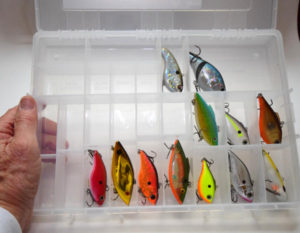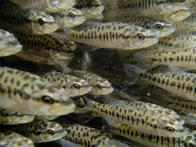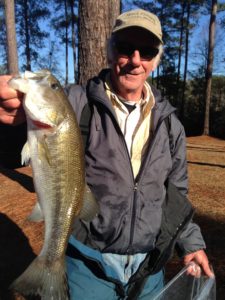Some Cold Weather Fishing Memories
For some reason, the song “Baby Its Cold Outside” kept going through my head last week. Putting a heat lamp on my well and my outboard motor lower unit is a common winter job, but it seems I haven’t had to do it for a few years. As always, weather changes from year to year.
Over the years I have had some interesting, experiences in the cold, some fun, others not so much. I seem to remember many very cold winters in my preteen years, but memories are often fallible. But some of the times outdoors over the years stand out.
Dearing Branch ran near our property line through the woods and under a culvert at Iron Hill Road. Where the pipe dumped water on the downstream side of the road there was the biggest hole in the area, about ten feet in diameter. The water was a few feet deep and we caught a lot of small fish there in the summer.
Most of the winters back then were cold enough that the surface of that hole froze solid. I learned to “ice skate” on that ice, sliding and falling across it. More than one time we broke through and had a cold run the quarter mile back to the house in wet pants and boots.
The ice was usually a couple inches thick. Luckily the hole was not deep enough to really be dangerous. If we broke through the ice it would wet us only about thigh deep at worst, and there was no danger of getting trapped under the ice as can happen on bigger waters. But mama fussed a lot, anyway.
Later, after I started bass fishing in the winter, I found out how important good clothes can be. I think I was one of the first people in Georgia to ever own a snowmobile suit and boots. But even with suitable cold weather clothes, there were a few times nothing I had was enough.
One Christmas Linda and I were staying in our little camper beside my parent’s mobile home at Raysville Boat Club. We had an electric heater running and we were comfortable in the bed. During the night our dog Merlin jumped up off her usual place under the bed and got into bed with us, a very unusual happening. She never jumped into the bed.
The next morning we found the reason. Her water bowl on the floor was frozen solid. The little heater produced enough heat to keep it bearable a couple feet above the floor, but on the floor, it was freezing.
That morning the thermometer on the porch showed five degrees, and the wind was blowing hard. I tried to go out fishing anyway. After putting the boat in the water I idled out of the cove and started hitting waves. The splash from the waves hitting the boat froze before they hit me, forming sleet between the boat edge and my snowmobile suit, hit it and fell off.
I turned the boat and went back to the ramp! No fishing that day.
Bass will bite even when it is extremely cold. One Sportsman Club tournament proved that. When I went through town on the way to Sinclair, the First National Bank thermometer read 11 degrees. We had problems at the ramp, when a boat was launched the water running off the trailer as it was pulled up the ramp froze
It was a scary feeling backing down the ramp and feeling your truck slide toward the water. As soon as the back tires got to the water the ice ended and the truck would stop. But trying to go back up the icy ramp was trouble. You had to spin your tires and basically melt the ice as you went up the hill.
We didn’t catch a lot of fish, but I managed to win with seven keepers by fishing a crankbait so slow it barely moved. And every cast we had to dip our rods into the water to melt the ice in the guides. On the way home that afternoon the bank thermometer read 17 degrees, the high for the day.
My pond has frozen over several times in past years but not recently. I caught my only “ice fishing” fish one year by knocking a hole in the ice at the end of the dock and dropping a bait through it. The small bream that I landed was enough to say I caught one, so I left.
Skipping a rock across a frozen pond makes an interesting sound. I found that out years ago when I threw one out to see if it would break through the ice. It didn’t but as it skittered over the ice it made a strange ringing sound. Several more proved it was the norm. I have seen videos on Facebook that showed the same sound.
Newer boat motors crank fairly well in cold weather, but old ones used to be very hard to start. But a worse problem is frozen steering cables. At more than one tournament we have launched boats, got the motor cranked only to find they could not be steered. Several tournaments have been won by people forced to fish around the ramp using their trolling motor because of that problem.
I got a scare a few years ago at a tournament at Jackson. It had been very cold, but my motor cranked. As I ran up the lake right at daylight suddenly a loud crunching sound made me think my motor had blown up. I stopped but the motor seemed to idle fine. Then I looked around and realized there was a sheet of quarter inch ice all the way across the lake. The sound was my boat acting as an ice breaker.
I hope I don’t make any more extremely cold memories this winter!


